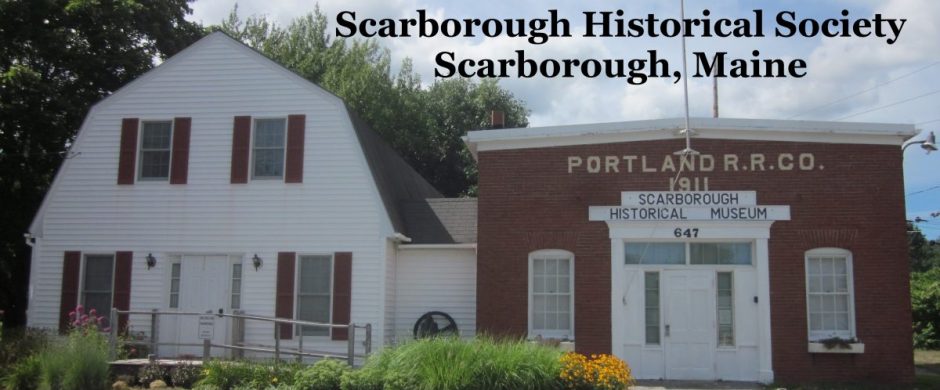By Linda McLoon*
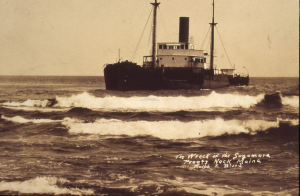
Wreck of the Sagamore, January 14, 1934
Scarborough Historical Society collections
It was snowing on Saturday evening, January 24, 1934, when the steel freighter, Sagamore, left Portland Harbor, bound for Boston with a hold filled mainly with large bolts of woolen material and oilcloth. The storm had intensified with a strong northeast gale when the Sagamore struck Corwin’s Rock off Cape Elizabeth, tearing a hole in the hull and disabling the steering mechanism. Fearing the ship would go to the bottom, Captain Ralph McDonough drove it as fast as he dared, hoping to beach it on land. The Sagamore grounded on the rocks off Prouts Neck, where the crew of 26 endured a terrifying night with the ferocious storm sending towering waves over the vessel. They were able to send flares to broadcast their position and in the morning the entire crew was rescued by the Coast Guard.
News of the shipwreck spread rapidly throughout Scarborough, a community that at the time was suffering through the Great Depression. Little was thrown away by families. Every home had rag and button bags, and zippers would always be saved for reuse. The final chapter of clothing was to have the material braided into a rug. Bent nails were hammered straight for recycling. Nothing went to waste.
Many people at that time were wearing threadbare clothes, with so few clothing items in a few families that kids took turns going to school. Housewives home canned vegetables from their large gardens, and many families had chickens. The cloth bags that chicken feed and flour came in were turned into clothing, dishtowels and pillowcases, with manufacturers often making the bags in patterns and colors to facilitate their reuse.
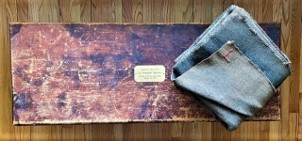
Carpenter’s Chest & material salvaged from the Sagamore
From the collections of Rodney Laughton
It was in this climate that Scarborough residents heard that the shipwrecked Sagamore was carrying woolen material. Elaine Frederick Killelea remembers vividly as a small child going with her parents to the rocks not far from the Prouts Neck bathhouses where people from the town had a big bonfire going against the January cold. She watched as small dories and rowboats made trip after trip to the stranded ship, salvaging bolts of the double-faced wool material and bright red or green oilcloth. Her mother fretted, because like most men at that time, her father had never learned to swim. For his reward, Walter Frederick got a china cup from the ship, which he always used for his coffee, and Elaine’s mother made him a gray coat from the material. Elaine got a new snowsuit, tan wool on the bottom and brown plaid on the top, made on an old treadle sewing machine purchased at the Prouts Neck rummage sale.
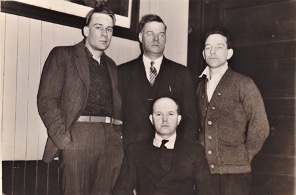
Officers of the Sagamore
Standing left to right: K.B. Glover, Third Of-
ficer; Perley Lawry and T. Bond, Second Of- ficer; Seated: Capt. Ralph W. McDonough, Master of the freighter
From the collections of Rodney Laughton
The grounding on the rocks had further crippled the Sagamore, and with her bottom gone, many more bolts of material were released into the water. Lots of them washed up on the beaches as far away as Pine Point, where they were eagerly gathered up. Eventually, people from farther away flocked to the Sagamore. On that Sunday morning, the Dunstan minister had announced the shipwreck from the pulpit, advocating his congregation to “Go forth to get material for our church!” And the Blue Point church got its first seat cushions covered with dark gray cloth from the Sagamore. Pine Pointers were accustomed to traveling by water to Prouts Neck, so perhaps many came to the scene by boat, resulting in a flotilla of lobster boats bringing salvaged cloth home.
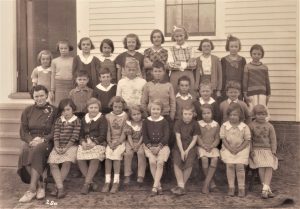
This 1934 photograph of the Black Point students includes Elaine Frederick, the fifth little girl from the left in the front row. The author’s mother, Barbara Harmon, was the teacher.
Photo courtesy: Scarborough Historical Society Collections
Elaine remembers that all the material was very wet and stiff, and that which had washed up on the beaches had to be spread out and cleaned of salt and sand, not an easy task. All the clotheslines for miles around were filled with the material being dried after cleaning. My mother was the teacher at the Black Point district school in 1934, and she had a suit made of the material. She remembered that most of the children in her class came to school wearing clothing made out of the same lovely woolen material, but nobody seemed to care. Residents were happy to have warm coats, dresses, jackets, and trousers.
What a boon the Sagamore’s cargo proved to be for the town of Scarborough! Those resourceful people provided the energy, expertise, and sewing skill to turn into a gold mine material that today would quickly go to a landfill. The Sagamore was never able to be refloated, and the masts of the ship were visible for years from the cliff walk.
*With greatly appreciated input from Elaine Frederick Killelea and Susan Snow.
[Note: This article was first published in two parts — Part 1 in the July-August 2020 issue of Owascoag Notes and Part 2 in the September-October 2020 issue.]
